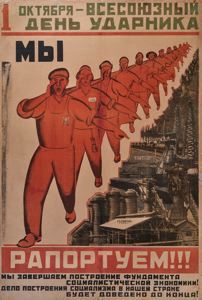The Russian Revolution marked the rise of a new state power that broke away from the Old World and vowed to crush the capitalist system in the interest of the toiling masses. Many revolutionaries, like Dada Amir, who were disillusioned by the "shameless hypocrisy" and "humiliating handicaps" of the Old World converged at USSR to be part of this new socialist project. Alongside making economic and political decisions, the newly-formed state wanted its people to understand the essence of social life and to internalize the alluring ideal of the new Soviet man. It was imperative for the regime to make a template of a new Soviet Man and make him a reality in the educational institutes, where international recruits like Dada Amir interacted with other local groups. Stalin called the New Soviet Man, the “little cog in the wheel”, that selflessly took responsibility to run the state’s machine and worked towards the collective welfare of people. Dada Amir’s autobiographical account provides a bottom-up view of how the cog was meant to function and realign himself with the socialist ideals. The ideal Soviet man was to be selfless, healthy, obedient , someone who had proletarian origins and gave collectivism and comradeship precedence over personal preferences. Through Dada Amir's journey, we can see his growth within the 'New Man' template from a recruit to a responsible communist who had to "set an example by consciously observing all the rules and regulations". He mentions his disregard for public property and rules in America and India, and the sudden rush of guilt he felt when he committed a minor mistake at a local station in Soviet Union. The New Soviet Man was the need of the hour for the Soviet economy, which is why many propaganda posters in public urged people to be active participants in the society who could work as 'cogs' within the Industrial setup. For example, the following poster was created in 1931, and it called workers to unite in favor of collective interest of the society. The individuals in red uniform could work within the economy, and enable the Soviet Union to combat international enemies.
 |
| 1931- All Union Day of the Shock Worker |
 |
| Death to World Imperialism |
The emphasis on collective action can also be seen in Dada Amir’s account, where he worked in the “Indian-American” group with men who came from diverse backgrounds. His institution taught him to celebrate diversity and work together regardless of their internal differences. This stands in sharp contrast to the American society that worked on the principle of “survival of the fittest” and “individual motive”. But in USSR, the New Soviet Men engaged in “collective efforts for the survival of the all” and derived their value from their contribution to the socialist state. Another poster called the ‘Death to Imperialism’ showcased this idea by showing the importance of group actions in bringing down the oppressive system. The contention between individual versus the society is a recurring theme in propaganda posters, and even in Dada Amir's account. He sacrifices personal commitments to attend committee meetings, and puts emphasis on the collective nature of his military training.

The concept of the New Socialist Man was also part of the proletarian internationalism. The characteristics of the ideal socialist man were not limited to the Soviet Union only, instead, they were internalized and exported by men like Dada Amir who could envisage a classless society in their homeland. After breaking chains from the Old World and turning into a new Soviet man, Dada Amir decides to let go of the personal advantages he would gain from working in America and decides to serve on the Indian soil which is ruled by imperialists. His regard for authority, party ideals, group activities may have given him a reason to emancipate the “politically slave nation”. After witnessing the rapid change within the Soviet society, he questions why the same could not happen in India? As part of the Soviet Union’s agenda, several posters were made that targeted workers that belonged to Subcontinent, and the Middle East. For example, one poster emerged in 1957, in which a multi-lingual group of men is seen walking in Moscow, seemingly content and relaxed. This diversity was also seen in Dada Amir’s account of his stay in the group that had black comrades who did not suffer racial discrimination in the socialist society. Lastly, the following poster uses the template of the new Soviet Man to urge the workers of Uzbekistan to work as "little cogs" in order to make locomotives.
 |
| Work hard to produce locomotives-Uzbekistan |




Comments